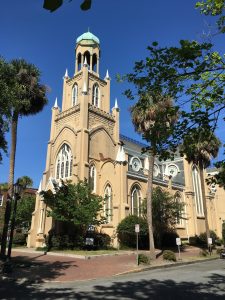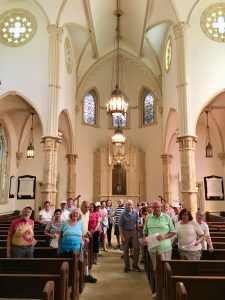Savannah’s Hope – A Weekly Letter From Rabbi Davis – May 11, 2018
Shalom Chaverim
Walking around Savannah, GA, our Beth El tour group eventually came to the synagogue. Our tour guide started talking about the history and the congregation. But people stopped her saying, “where is it? I don’t see it.” “It’s right there,” she said pointing. Still, people didn’t see it. That’s because the Temple looks so much like a church they couldn’t believe that it was the synagogue.
saying, “where is it? I don’t see it.” “It’s right there,” she said pointing. Still, people didn’t see it. That’s because the Temple looks so much like a church they couldn’t believe that it was the synagogue.
Established as a congregation in 1733, the current Temple was built in 1876. It is the only synagogue in America in the shape of a cathedral. That Gothic design was the height of Victorian fashion in its day. Inside, there are the familiar synagogue trimmings- an ark, yahrzeit plaques, and stained glass with Jewish motifs.  But still, it looks and feels like a cathedral- and a beautiful one at that.
But still, it looks and feels like a cathedral- and a beautiful one at that.
We got lucky the day we visited- they completed building renovations the day before we arrived. So we were the first group to see it restored. We toured the sanctuary, listened to a recording of the organ and choir, visited its museum of historic artifacts and davened mincha in its majestic sanctuary. When we davened, I was moved singing Lador vador. I could picture and almost feel previous generations join in our tefilot.
Just as we finished our service, a bar mitzvah boy came in for his final dress rehearsal. And that for me was the perfect conclusion to our trip. We had spent the week learning history, culminating in this congregation’s illustrious, 200 year old story. But this was not just a trip to the past. We saw a living congregation, a small but vital community.
And that is captured in the Temple’s very name- Mickve Israel (Hope of Israel). The name comes from this week’s haftara in which the prophet Zacharia describes God as the Hope of Israel (mikvah) and calls on the people to drink from “the Fount of Living Waters.”
When the congregation was founded, Mickve Israel was also the name of a popular, messianic book written in 1648 by Amsterdam rabbi, Manashe ben Israel. The book paved the way for the Jews exiled from England in 1290 to be welcomed back in 1650. By choosing this name for their congregation, Savannah’s Jews reaffirmed their right to settle this English colony in the New World. Establishing what was then America’s largest Jewish community, it must have felt like the dawning of the messianic era.
Today, Savannah is a small Jewish community, proud of its heritage and hopeful for the future. No wonder why one Beth El member said that his favorite moment of the trip came just after he finished exploring the Temple’s history museum and met the upcoming bar mitzvah boy.
L’Shalom,
Rabbi Alexander Davis
